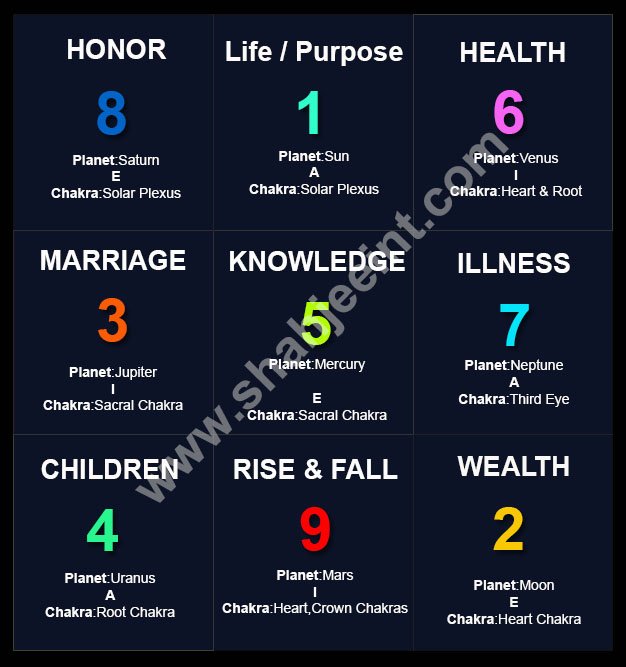 A numerology expert should be so proficient in this art that they can derive accurate answers to every question from the numerology chart. This is because a numerology chart is not just a mere chart but a secret book containing hidden clues about the past, present, and future. Each house in the chart continuously changes its state according to time and the nature of the question. The qualities of the numbers from 1 to 9, depending on the houses they occupy, also fluctuate throughout the day.
A numerology expert should be so proficient in this art that they can derive accurate answers to every question from the numerology chart. This is because a numerology chart is not just a mere chart but a secret book containing hidden clues about the past, present, and future. Each house in the chart continuously changes its state according to time and the nature of the question. The qualities of the numbers from 1 to 9, depending on the houses they occupy, also fluctuate throughout the day.
Each house in the chart has specific attributes. No number is inherently auspicious or inauspicious; however, due to its position and different statuses, a number can become either auspicious or inauspicious. This chart is designed in the form of a Mussallas. The extracted number is placed in the first house, and the remaining numbers are arranged sequentially in the corresponding houses.
Let’s understand this with an example.
This is our Original Numerology Chart Structure here that we will use for calculations.

A man wanted to understand his circumstances, so he had his chart prepared. His Adad-e-Mustahsila (numerological number) was 7. Therefore, we placed the number 7 in the first house and filled in the remaining numbers accordingly.
The chart was as follows:

- The first house is Sa’ad (auspicious), and the number 7, which is also Sa’ad, is placed there. This number is associated with the completion of matters. Since both the house and the number are auspicious, it indicates that the inquirer will complete their tasks successfully and smoothly.
- The second house is neutral (Masawi), meaning neither auspicious (Sa’ad) nor inauspicious (Nahs). However, it contains the number 8, which is neutral. Since the number and the house are neutral, this number relates to destructive affairs, suggesting that there will be no obstacles in their completion.
- The third house contains the number 9. The third house is Nahs (inauspicious), and the number 9 is also present, meaning “rise after decline.” This indicates that the person’s work will progress, but only after some delays.
- The fourth house contains the number 1, which is Sa’ad, and the house itself is also Sa’ad. The fourth house relates to offspring and income, suggesting that the person will see financial improvement soon.
- The fifth house is neutral and contains the number 2, which is associated with emotional sensitivity and also with knowledge and skills. This means the inquirer will achieve success in the future through education and expertise.
- The sixth house contains the number 3, and both the house and the number are Nahs. This implies that the person’s work completion will require financial expenditure, and there is also a risk of health issues.
- The seventh house contains the number 4. The house is Sa’ad, while the number is neutral. This house represents worldly affairs, indicating that after completing their objectives, the person will achieve financial and material success.
- The eighth house contains the number 5. The house is neutral, but the number is Sa’ad. This relates to the power of attraction (Quwat-e-Jazba), indicating that the inquirer’s personal magnetism will help in achieving their goals.
- The ninth house contains the number 6, which suggests that after accomplishing their goals, the person may face envy from others.
These were just answers to basic matters, whereas by delving into the depths of a numerology chart, one can find answers to every life problem. It can also reveal things that an ordinary person could never even imagine.

